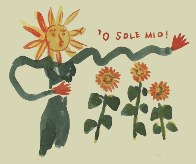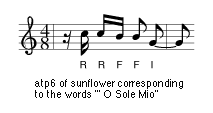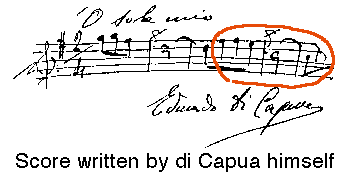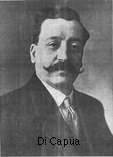 A flower which represents summer is the sunflower. It is called Himawari
in Japanese which means turning with the movement of the sun. The same is
true for the corresponding French word and the sunflower is called tournesol.
However, according to botanists, the sunflower does not always face to the
sun although it moves with time. A flower which represents summer is the sunflower. It is called Himawari
in Japanese which means turning with the movement of the sun. The same is
true for the corresponding French word and the sunflower is called tournesol.
However, according to botanists, the sunflower does not always face to the
sun although it moves with time.
A well known function of plants including the sunflower is photosynthesis:
carbon dioxide as a raw material is transformed by the optical energy from
the sun into organic compounds, which are used to make grow and maintain
plants, and oxygen necessary for respiration.
Respiration using oxygen produced by plants through photosynthesis is inevitable
for almost all living creatures. Deeply concerned with respiration is an
organ called mitochondria. In this organ, energy is stocked as ATP through
respiration. Whenever necessary, ATP can be decomposed to produce energy,
which is used, for example, in animals for such activities as control of
body temperature and contraction of muscles. In this way, ATP is used to
stock energy or consumed to produce energy used for a variety of activities
in living creatures, and therefore can be regarded as a sort of energy "currency".
Filling energy with "'O Sole Mio"
Mitochondria is of course included in the cells of sunflowers. The protein
which plays an important role in producing ATP is atp6. Dr. Sternheimer,
who has discovered the music of proteins, says: "The melody promoting
the synthesis of a protein called atp6 contained in  mitochondria
of sunflowers reproduces the passage corresponding to the very words of
"'o sole mio" of the song "'O Sole Mio"". How interesting
if we imagine the scene that sunflowers stock enthusiastically energy in
their cells as ATP while singing "Oh my sun!" to the brilliant
sun of the summer! mitochondria
of sunflowers reproduces the passage corresponding to the very words of
"'o sole mio" of the song "'O Sole Mio"". How interesting
if we imagine the scene that sunflowers stock enthusiastically energy in
their cells as ATP while singing "Oh my sun!" to the brilliant
sun of the summer!
"'O Sole Mio" is, as you know, a napoletana or a popular
song of Naples. It is said that the song was composed in 1898 by Eduardo
di Capua when he was staying in Odessa in Ukraine with his father. Returning
to Naples,  he participated in the music festival of Madonna di Piedigrotta
held in September with the song. This was the first occasion that "'O
Sole Mio" was sung in front of the general public. he participated in the music festival of Madonna di Piedigrotta
held in September with the song. This was the first occasion that "'O
Sole Mio" was sung in front of the general public.
"'O Sole Mio" could get only the second prize at the festival,
but the song became known all over the world owing to the world famous tenor
Enrico Caruso who sang the song as his repertoire. Well known songs such
as "Torna a Surrento" or Return to Sorrento were also first sang
in this festival.
Sunflowers helped to produce the hit song?
Odessa in Ukraine where di Capua stayed faces to the Black Sea and is
characterized by a mild weather with sunlight all year. Odessa is also a
city situated in a rich granary. A main farm product is, to our surprise,
sunflowers. To eat grains or to obtain sunflower oil, Russians cultivate
 sunflowers on a large scale: Ukraine is one of the most famous sunflower-growing
district in the world. sunflowers on a large scale: Ukraine is one of the most famous sunflower-growing
district in the world.
In the suburbs of the city, endless sunflower field comes into sight. Di
Capua also should have seen the sunflower field. I would like to dare to
imagine that the melody corresponding to the words of "'o sole mio"
might come across his mind inspired by the voiceless talk of the sunflowers
to him.
Di Capua composed many hit songs such as "'Oh Sole Mio" while
earning his living by playing in small theaters, cafes and cinemas in and
around Naples. However, he could not benefit from the hit songs because
he did not know the world.
One day he said to his wife that he would die if he had to dispose of his
piano. Just as his words, when he sold his piano because of the necessity
to make money, he fell ill and died in extreme poverty in a hospital. What
irony it is that he composed in "'O Sole Mio" a melody which promotes
the production of ATP or the "currency" in living creatures, while
he could not even afford the money to lead the simplest living in the real
world! |
 A flower which represents summer is the sunflower. It is called Himawari
in Japanese which means turning with the movement of the sun. The same is
true for the corresponding French word and the sunflower is called tournesol.
However, according to botanists, the sunflower does not always face to the
sun although it moves with time.
A flower which represents summer is the sunflower. It is called Himawari
in Japanese which means turning with the movement of the sun. The same is
true for the corresponding French word and the sunflower is called tournesol.
However, according to botanists, the sunflower does not always face to the
sun although it moves with time. mitochondria
of sunflowers reproduces the passage corresponding to the very words of
"'o sole mio" of the song "'O Sole Mio"". How interesting
if we imagine the scene that sunflowers stock enthusiastically energy in
their cells as ATP while singing "Oh my sun!" to the brilliant
sun of the summer!
mitochondria
of sunflowers reproduces the passage corresponding to the very words of
"'o sole mio" of the song "'O Sole Mio"". How interesting
if we imagine the scene that sunflowers stock enthusiastically energy in
their cells as ATP while singing "Oh my sun!" to the brilliant
sun of the summer! he participated in the music festival of Madonna di Piedigrotta
held in September with the song. This was the first occasion that "'O
Sole Mio" was sung in front of the general public.
he participated in the music festival of Madonna di Piedigrotta
held in September with the song. This was the first occasion that "'O
Sole Mio" was sung in front of the general public. sunflowers on a large scale: Ukraine is one of the most famous sunflower-growing
district in the world.
sunflowers on a large scale: Ukraine is one of the most famous sunflower-growing
district in the world.